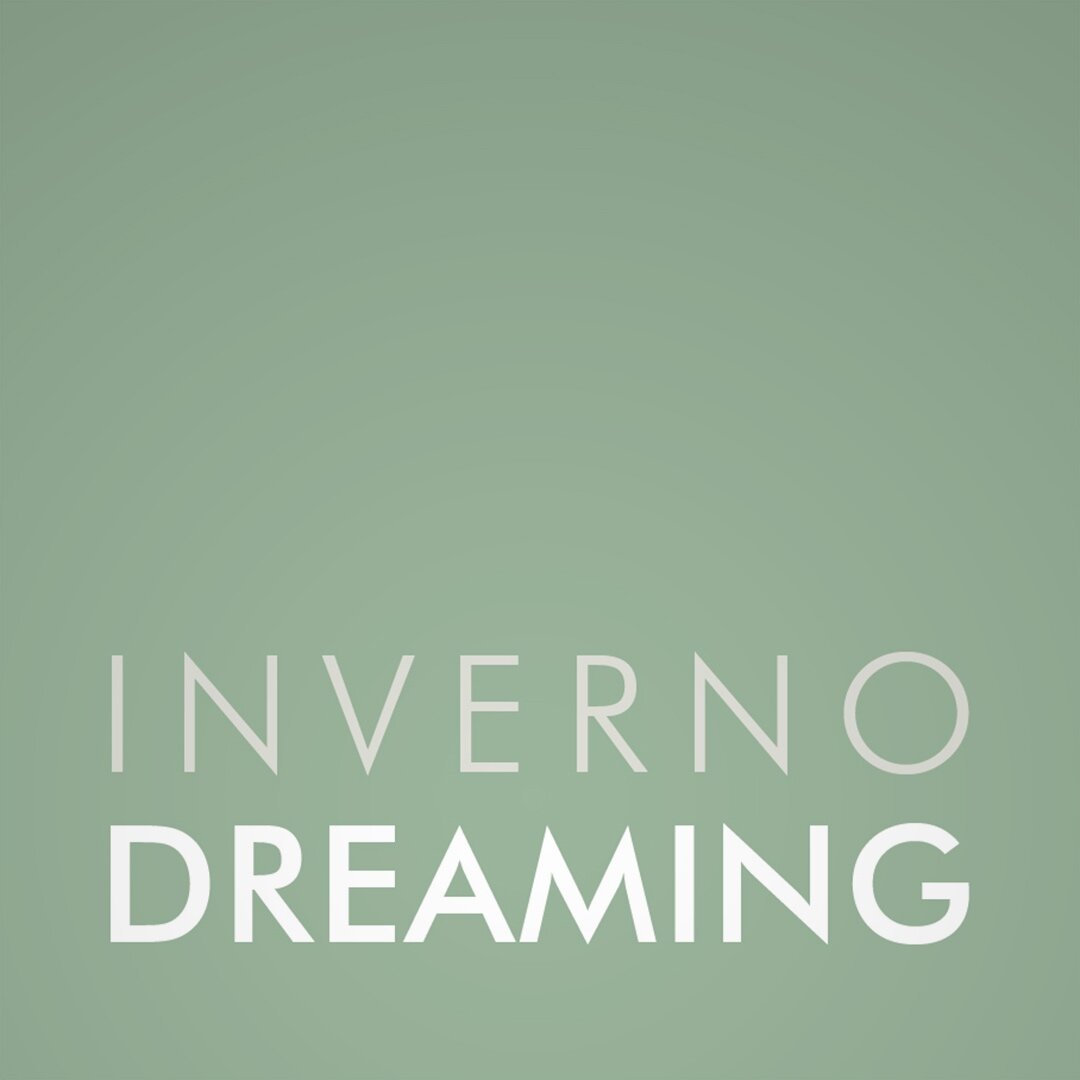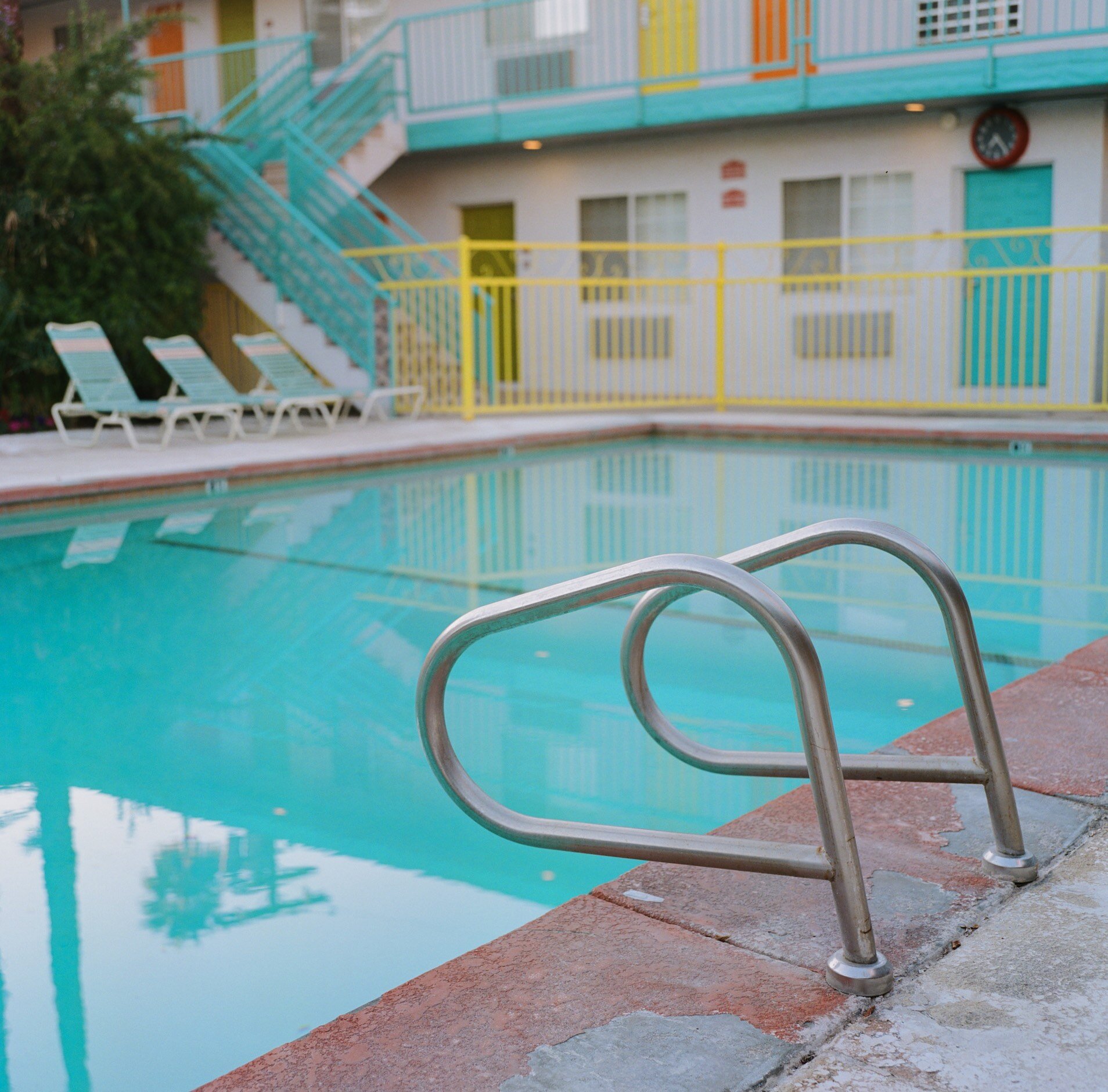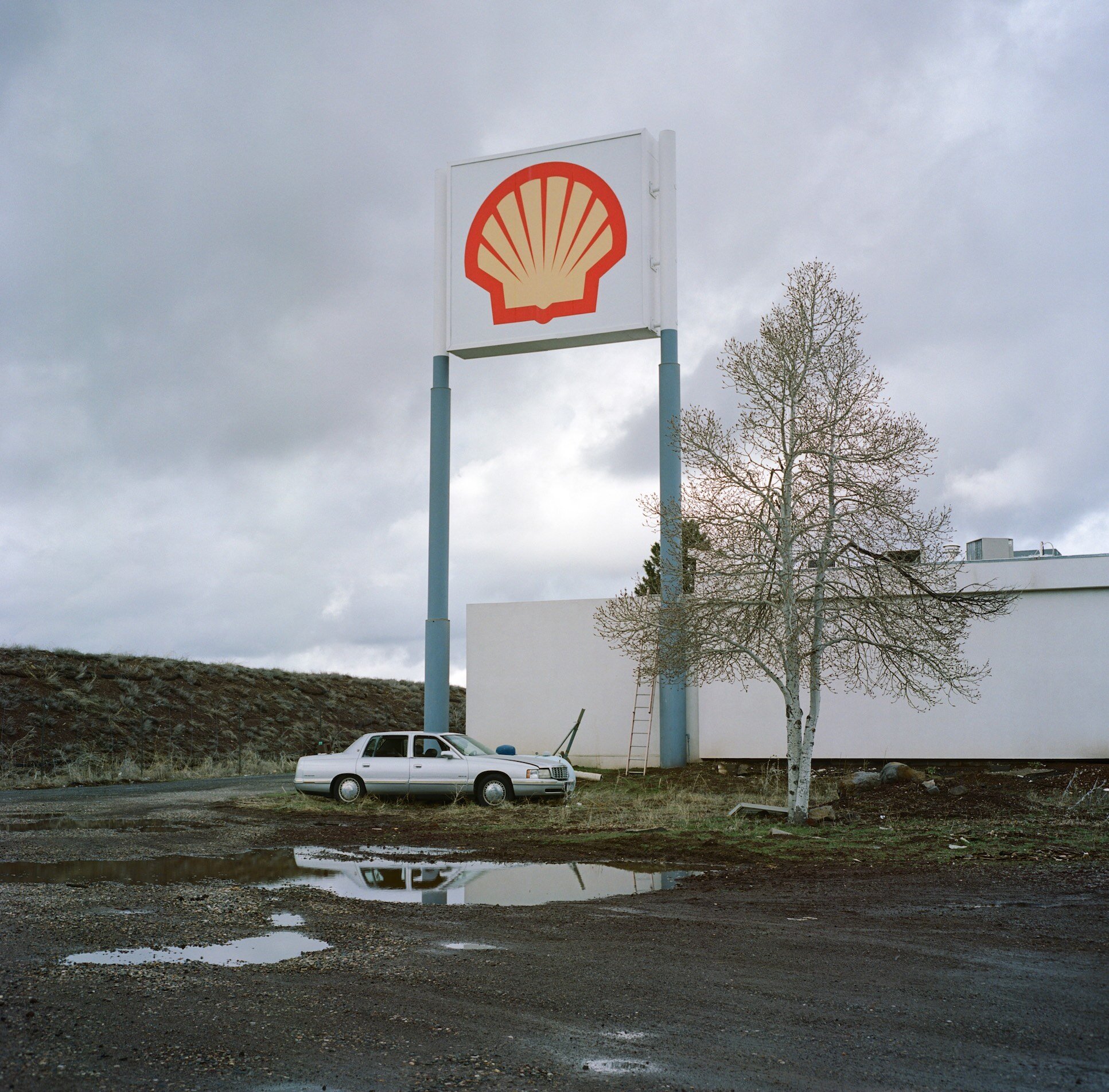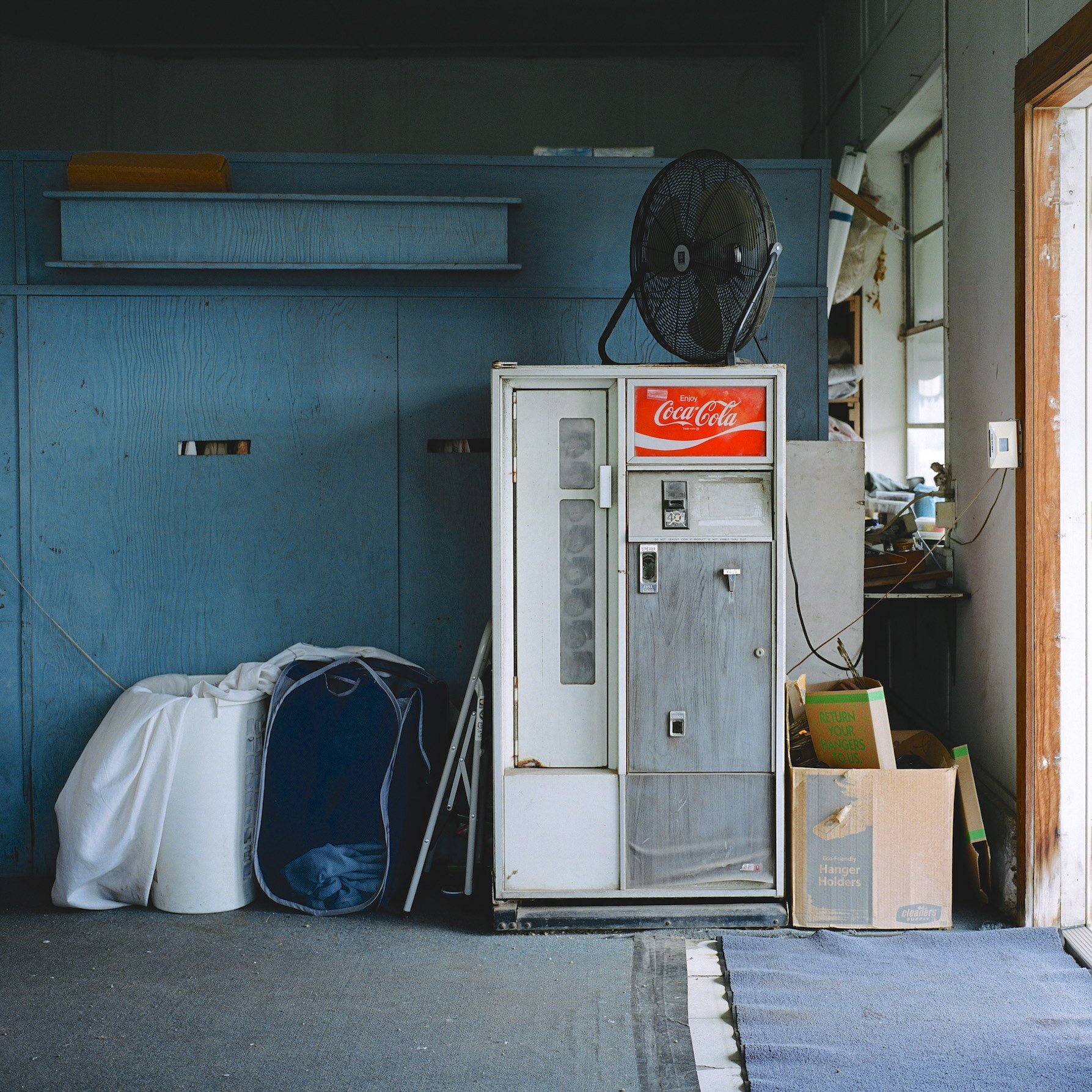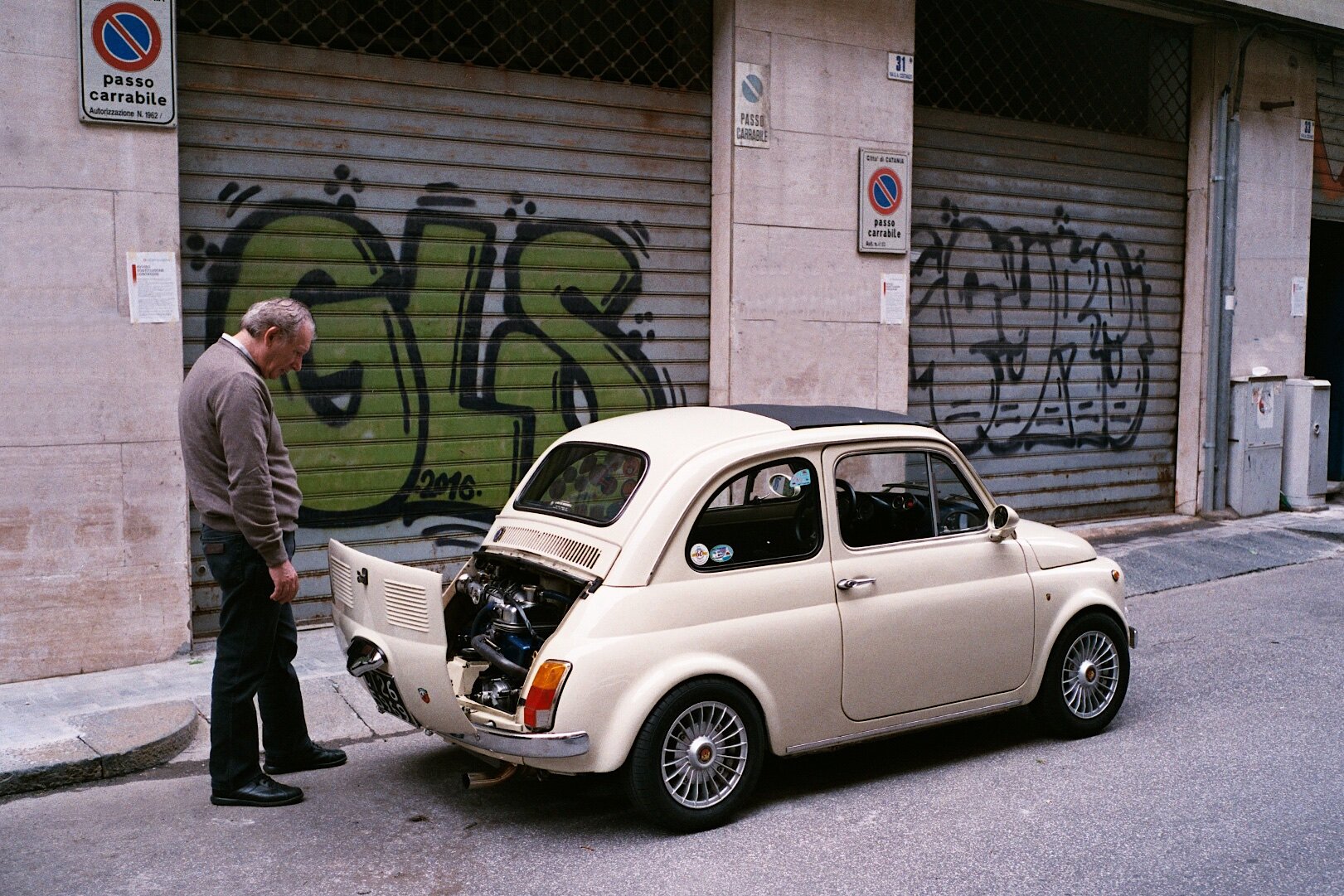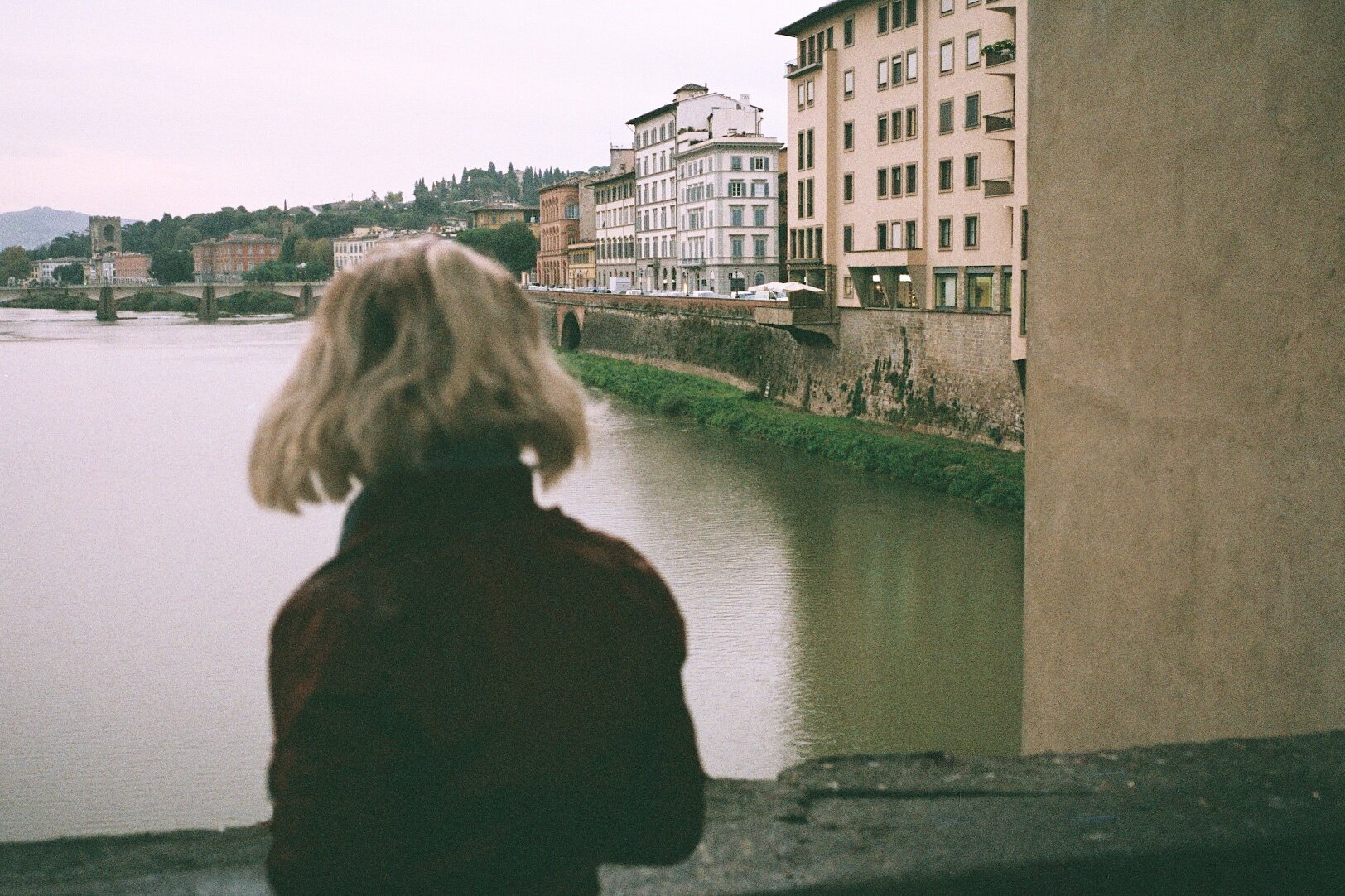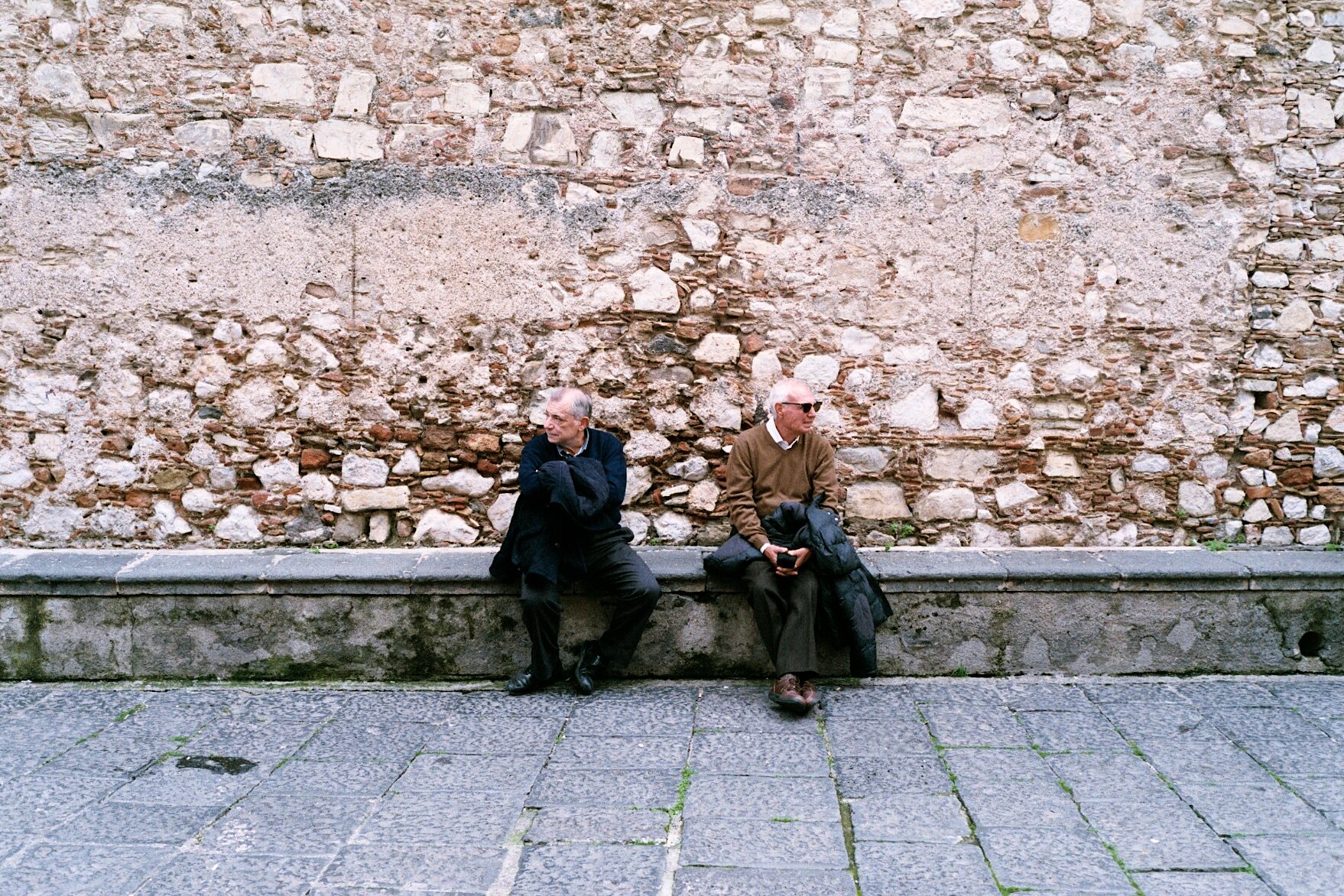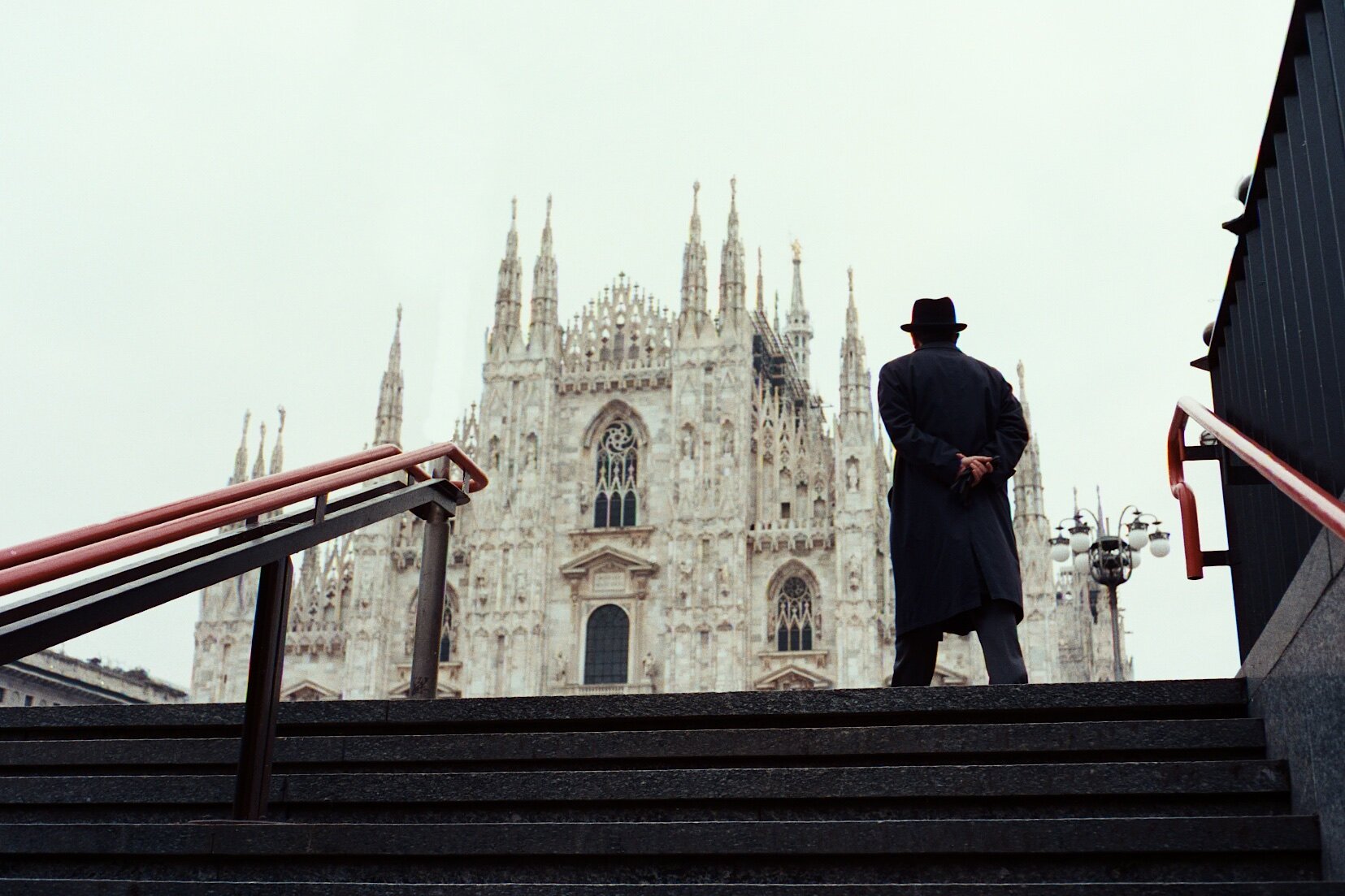an interview with Mark Forbes
Some years ago I came across a photo of a smashed car wedged between two huge converging walls of concrete. I was immediately arrested by this photo's content, light and colour and its sense of destructive beauty. Like the tightly squeezed car, crammed into this single frame was so much potential story. How? Where? Why? Of course, from that moment I had to follow and see more from its photographer.
Based in Melbourne, Mark Forbes shoots quiet scenes of the everyday in a documentary style where urban corners and vistas are framed and composed in such a way to as to bring a striking beauty to the familiar and mundane. So after years of looking at his pictures, I thought now might be a good time to ask him about his work and photographic influences.
• Mark, can you tell me a little about yourself?
Hi Tom, thanks for having me on board for this interview. Sure, so I was born in Middlesbrough, England to Scottish parents and spent some of my childhood in England, some in Sydney, some in the Netherlands and the last few years of my high school were in Melbourne. As a family we did a lot of travelling at all ages, moving from country to country and often only living in one place for a few years at a time, before moving again. One of my favourite memories as a child was being in airports and on planes travelling from place to place. It was like we were always going somewhere new and mysterious. I’ve definitely taken this love of travel through to my adulthood.
• How and where did you discover photography?
My dad had a picture he took from a sailing boat in Sydney harbour enlarged and hung on the wall. That really is my first memory of any photograph. The first time I have any vivid recollection of taking pictures myself is when I was at school in the Netherlands in year 10 (15 years old) and we were leaving to move to Sydney. Usually we were not allowed to bring cameras to school, but as I was moving I snuck in a little film point and shoot (it could have been a disposable) to take photos of my friends in my last days there. So it was really all about taking pictures to not want to forget things - which at the simplest level is I think why many photos are taken. After that I really don’t remember much about photography in my life until after leaving university and buying a film SLR at the airport to go on a trip to Europe.
• How does photography work for you as a creative form?
It works for me at in the most basic sense in terms of being a way to communicate visually with other people the things that I see on a day to day basis. When I approach a scene I tend to find that there is really only generally one way that I think it looks the most interesting or the way that I want to capture it - often this is a view that comes very quickly. I get a sense of peace and calmness when I photograph, and also a deep sense of enjoyment. It’s like time can be irrelevant often and you are really able to zone into something that consumes you. You can forget all of your worries and focus on where you are and how you want to photograph something or someone. I really enjoy finding beauty in things that most people wouldn’t initially identify with or wouldn’t easily connect with. I’ve had people approach me when I’m photographing something ordinary and ask me what I’m taking an image of - and then when they stand with me and I talk them through it, more often than not they will get an appreciation for something that they just were not aware of.
• Platforms, waiting rooms, petrol stations and airports, I sense a recurring transport inspired theme in your work, more than you just travel a lot. What is your photographic relationship with these places?
You’re spot on - I enjoy photographing each of these transitory spaces and I’m certain that my upbringing of regular travel and moving around the world as a child has played a big part in my attraction to these scenes. For me each of them represent memories of going somewhere else, somewhere new to explore, and these scenes represent that feeling of a journey more so than the final destination. They are also places where unlimited stories unfold - as many of us can understand the feeling that is being experienced when looking at the images. There is also the mystery and wonder of thinking about where other people have been and where they are going as they pass through these places of transition. There is also the tinge of loneliness that exists in images that can come from a transitory scene, which can be both beautiful and somewhat sad at the same time.
• For me, your work leans toward documentary but you seem very happy to include people in your frames, in a sort of urban landscape/street photography combination. Do you intentionally overlap genres?
The first thing that I really enjoyed photographing as I got more seriously into photography was street photography in the traditional sense of the word - with the aim of capturing the “decisive moment” that is often understood to be a classic approach to the genre. I followed this approach for quite a few years before felt like I wanted to experiment more with a slower approach to photography. I found that I naturally tended to include fewer people in my images and was more interested in spaces and scenes.
I don’t really tend to think about genres when I’m out shooting, or even when I’m not - it’s more a process of what I feel like photographing at the time, which is driven by a myriad of things. So more of a gut instinct than a decision to have people in an image or not. I think that street photography is a subset of documentary photography. While I think of myself as a documentary photographer, I have also recently become interested in directing my images more in terms of the specific use of people in a given scene of interest - this is something that I’m only just starting to work on at present.
• In your ongoing series American Dreams, there is a definite documentary and topographic feel. This differs with your series The Italian Job where most frames are populated with human figures. How did you decide on this different approach?
I think the difference between those two series can be explained somewhat by the answer above. The Italian Job series was made at the end of 2018, whereas the American Dreams series that has been made so far was shot in early 2020. So I think that towards the end of the Italy trip a lot of my images tended to have fewer people in them, this then continued in the time between my travel to the USA. Another driver of the difference is the fact that a lot of the Italian series was photographed using 35mm - I brought an M6 and Mamiya 7 with me. I find that when I’m shooting 35mm the images tend to be quite different, in terms of content than if I’m photographing in medium format. When I was in the USA, I photographed almost exclusively using either a Mamiya 7 and a Rolleiflex - so medium format. Again this forces you to slow down and changes the way you approach a scene. Lastly I think the areas that I was visiting did impact the final images too, as in Italy I spent some time in the cities, whereas a lot of the images in the USA series were made in rural areas - where there are naturally fewer people.
• Can you explain how you approach a shot, what attracts you to a scene and how you interact with a location?
I tend to do a lot of walking and often find that the vast majority of images I take occur on the journey from one place to another. Sometimes I will hop on the train to a new location and just explore what I find when I get there - it’s the mystery of not knowing what you’re going to find that is part of the enjoyment of photography for me. Other times I will be driving along and see something down a side street that catches my eye and turn off to check it out. There are of course also times where I will see something in a magazine or on the internet that looks interesting, or i’m going on holiday somewhere specific and will plan out heading to a specific location for an image i’ve got in mind. When I approach a shot, very often I will find one angle that is the way that I want to represent a given scene. I tend to find this usually happens quite quickly - as if there is only one way that I can properly connect with something visually. Occasionally a scene or space needs a lot of scouting or walking around to get an angle that I agree with and I’ll take a few different photos to see what works best. There are times when I’m outside shooting and there is changing light - from full sun to clouds. If I want something to be cloudy I’ll happily wait for a few minutes (assuming i’ve got time) until the clouds give me the light that I’m looking for. So really there is a mix of various things going on, but quite often a lot of the images I take are just events that happened to occur during my day whether I’m out with the intention of photographing or not. So as much as possible i’ll try and take a camera with me when I’m out and about.
• You shoot with film, what are the characteristics of analogue photography that appeal you?
There are so many reasons that help to answer this for me. Firstly there is the tangibility of having the photo recorded on a physical negative - I enjoy holding them, scanning them, cutting them into strips, sliding them into the sleeves, writing on the sleeves and filing them away. I’ve always been fascinated about the power of a photography to document something and I think that having a physical record is an important part. Then there is the fact that there is no way of reviewing what you’ve just shot. This means that when you’re out and shooting on film, you get more time to actually focus on being in the moment and I’ve found that it actually makes the experience of shooting much more enjoyable. I honestly believe that shooting film has improved my photography, as instead of going out and shooting 10 similar frames of one scene, you think more about what you’re going to shoot on film and often approach a photograph with more intent - resulting in more keepers (and less photos to review later). Delayed gratification - the joy of scanning and seeing photos that you (forgot that you) shot weeks ago is tangible. Seeing images for the first time a week or sometimes month after they’ve been taken really feel like opening surprise Christmas presents. The limitations of film, from an ISO point of view, force you to be more creative - and so you end up shooting very differently. When I was in Tokyo a few years ago, the quickest film I bought was ISO400. At night in the city, if I’d have been shooting a digital camera I would likely have set the camera at ISO3200 and shot with a high shutter speed. As I only had the film camera with 400 speed film in it, I ended up shooting at shutters of 1/8 or 1/15 resulting in some motion blur and a completely different feel to all of my other daytime images. There is also the ability to continue to use all of the incredible and well made film cameras from decades ago. The lenses and films used give the photos produced a look that can’t be replicated using digital cameras. For my personal work I just prefer to shoot film. Long answer to a short question.
• You appear to favour colour over black & white, can you tell me a bit about why colour works best for you and what is your favourite colour film?
It’s funny, when I started taking photography more seriously a while back I used to convert a lot of my digital images to black and white in post processing. I think i must have thought that “serious” photos were shot in black and white - maybe this came from the fact that traditionally all photography was made in black and white? This was also around the time when I was shooting a fair bit of street photography too. As I started to shoot film more again, initially I shot the majority of it in black and white too - a mixture of Trix & Tmax. Then I started to add in the odd roll of colour film in too. I found that I was getting my scans back, I was really enjoying the native colours in the images a lot - they just seemed a lot more authentic than the colours that I was getting from my digital images. I also found that it somehow gave me more of an appreciation for the colours that I was seeing as I was out photographing too - and I gained an understanding more for colours that worked together in a given scene. There are beautiful colours all around us, and I think the process just enabled me to see this more easily. My favourite colour film is Kodak Portra 400 in 120. I find that it really produces colours the way that I like to represent them and really has great latitude in day and night scenes.
• Who are your photographic influences?
To be honest, it is only recently that I’ve spent some time looking in detail at the work of many other photographers, and while I could name lots, here are 10 of my favourites: Trent Parke, Todd Hido, Mark Power, William Eggleston, Richard Mosse, Stephen Shore, Joel Meyerowitz, Greg Girard, Harry Gruyaert, Gregory Crewdson.
• Is there an area of photography that you would like to explore more in the future?
Yes, I’m keen to explore directing my images a little more to see where that could lead to - including environmental portraits.
• We can’t end this interview without mentioning cars, you shoot a lot of cars. What is it about them that attracts you, is there a profound creative reason or are you just a petrolhead who can’t resist a cool motor?
I do have a serious penchant for photographing cars from bygone eras, although this is getting a bit more under control recently (I think). For me I think it is more than just the interesting scene itself. Older cars again take me back to my memories from childhood when I can remember using a pencil to trace and draw out their shapes from a book that my parents bought me. Endlessly flipping through and sketching all of the cars over and over. There is also the documentary aspect, as older cars genuinely are part of history that need to be preserved as their numbers diminish around us. The older cars also seem to have their own personality - as people have owned and loved (to various extents) these cars for sometimes decades, ageing in parallel with them. Lastly I think that there is also a huge nostalgic factor at play too. I have always loved looking at old photos in general, and it just makes you wonder what life was like. So I guess photographing them is just a way of capturing that feeling.
If you want to see more of Mark's work you can follow him on Instagram at _markforbes_ or on his website at www.markforbes.com.au
© All Rights Reserved | Mark Forbes 2021
